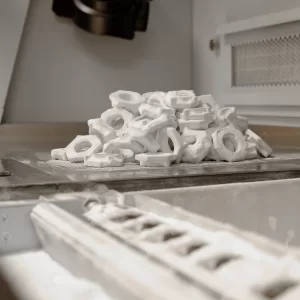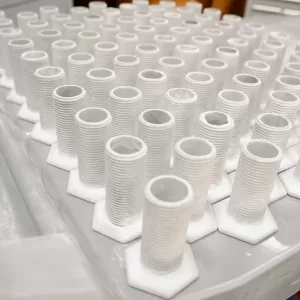Comparing Manufacturing-Grade 3D Printing Services: What You Need to Know
In today’s fast-paced, innovation-driven world, businesses are constantly seeking ways to streamline their manufacturing processes and bring products to market faster. This is where manufacturing-grade 3D printing services come into play, revolutionizing the way companies approach prototyping and production.
3D printing technology has advanced significantly in recent years, making it possible to create high-quality, functional parts suitable for a wide range of industrial applications. By leveraging the power of additive manufacturing, businesses can now access a whole new realm of possibilities for their product development and manufacturing needs.
From automotive and aerospace to healthcare and consumer goods, industries across the board are recognizing the immense potential of manufacturing-grade 3D printing services. These services offer the precision, speed, and versatility needed to keep pace with the demands of modern manufacturing.


IWhat is Manufacturing-Grade 3D Printing?
Manufacturing-grade 3D printing refers to advanced additive manufacturing services that produce parts suitable for commercial and industrial applications. These services employ cutting-edge technologies and materials to deliver high-quality, functional components that meet the rigorous standards of modern manufacturing.
What sets manufacturing-grade 3D printing apart is its ability to handle large production runs and complex designs with unparalleled precision and efficiency. By leveraging industrial-grade equipment and expertise, these services can create parts with excellent mechanical properties, dimensional accuracy, and surface finish.
Some key characteristics of manufacturing-grade 3D printing include:
- Industrial-grade materials: The use of high-performance polymers, metal alloys, and composites specifically engineered for additive manufacturing applications
- Advanced technologies: Utilization of state-of-the-art 3D printing systems, such as Multi Jet Fusion (MJF), Selective Laser Sintering (SLS), and Direct Metal Laser Sintering (DMLS)
- Scalability: The capacity to handle both low-volume production runs and larger-scale manufacturing needs
- Design optimization: Expertise in design for additive manufacturing (DfAM) to ensure parts are optimized for 3D printing processes
By partnering with a manufacturing-grade 3D printing service provider like we offer at Upsurge, businesses can access the full potential of additive manufacturing technology. This enables them to accelerate product development cycles, reduce costs, and unlock new possibilities for innovation and customization.
IBenefits of Manufacturing-Grade 3D Printing Services
Manufacturing-grade 3D printing services bring numerous advantages, particularly the ability to drastically reduce design cycles. By incorporating 3D printing into production workflows, companies can swiftly transition from concept to prototype, facilitating rapid testing and refinement. This efficiency not only shortens the path to market readiness but also enhances adaptability to shifting consumer demands and innovations in technology.
One of the standout features of 3D printing is its capacity for creating highly complex designs and detailed structures. Where conventional manufacturing might struggle with limitations in geometry, additive manufacturing excels—enabling the production of parts with intricate internal frameworks and custom configurations. This capability fosters new avenues for creativity and precision in engineering, allowing designers to push the boundaries of what is possible.
Cost-efficiency remains a pivotal consideration for businesses, especially in scenarios involving limited production runs or bespoke components. Manufacturing-grade 3D printing offers a solution by minimizing the need for expensive tooling and molds, thereby lowering upfront costs. This economic advantage makes it suitable for producing specialized parts that might be prohibitively expensive through traditional methods. Furthermore, the diverse array of materials available—from advanced thermoplastics to durable metallics—ensures components can be tailored to meet the distinct needs of various sectors, enhancing versatility and functionality.
IMulti Jet Fusion (MJF) Technology for Manufacturing-Grade 3D Printing
Multi Jet Fusion (MJF) represents a significant advancement in the field of additive manufacturing, offering a sophisticated powder-based method that excels in producing parts with superior mechanical integrity and precision. Through an innovative process that simultaneously applies fusing agents and energy, MJF achieves a high level of detail and robust physical properties in the final product.
The MJF technology is particularly suited for applications requiring rapid prototyping and efficient production of functional components. Its ability to create parts with fine surface textures and accurate dimensions minimizes the need for extensive post-processing, thereby streamlining production workflows. This efficiency makes MJF a preferred choice for industries that demand both aesthetic and functional excellence in their components.
Sectors such as automotive, aerospace, medical devices, and consumer goods leverage MJF for its ability to produce lightweight yet durable parts. In the automotive and aerospace industries, MJF facilitates the production of components that contribute to enhanced performance and reduced weight. For medical devices, the precision of MJF manufacturing ensures that components meet stringent safety and efficacy standards. The consumer goods sector benefits from MJF’s rapid iteration capabilities, allowing for swift adaptation to changing market demands. This technology’s adaptability and performance underscore its pivotal role in advancing modern manufacturing practices.
IChoosing the Right Manufacturing-Grade 3D Printing Service Provider
Selecting the right partner for manufacturing-grade 3D printing involves a careful assessment of several critical factors. The provider’s experience in your specific industry can make a significant difference in the outcome of your projects. This expertise ensures that the service provider understands the unique requirements and challenges associated with your sector, whether it’s the precision needed in aerospace components or the biocompatibility demands in healthcare applications. Companies with a proven track record in your industry are more likely to offer insights and solutions that are tailored to your specific needs.
Quality control processes are fundamental to ensuring that the parts produced meet the stringent standards required for industrial applications. It’s crucial to evaluate a provider’s quality assurance protocols, and their ability to consistently deliver parts that adhere to your specifications. Providers that integrate rigorous inspection methods and maintain high standards are more likely to produce reliable and consistent results.
Finally, a service provider’s design and engineering support can be a decisive factor. Providers offering collaborative engineering services can significantly enhance the design and manufacturing process. This includes capabilities such as design simulation, topology optimization, and real-time feedback during the design phase. Such support ensures that your project not only meets manufacturability requirements but also achieves optimal performance and cost-effectiveness. A provider that partners closely with you will often unlock innovative solutions and successful project outcomes.
IStreamlining Your Manufacturing Process with 3D Printing Services
Incorporating 3D printing into your manufacturing strategy can revolutionize how products transition from initial concept to final output. By weaving additive manufacturing into the production fabric, companies can establish a more dynamic and responsive workflow. This integration facilitates quicker adjustments and enhancements during the design phase, bypassing the delays commonly associated with traditional production methods.
Utilize the unique capabilities of manufacturing-grade 3D printing at various production stages. For initial design validation, 3D printing serves as a versatile platform for creating detailed physical models quickly, allowing for immediate functional assessments. This reduces the cycle time for feedback, making it easier to identify and address potential design improvements. When it comes to creating operational prototypes, the precision and material diversity available in 3D printing enable the production of models that faithfully replicate final product specifications, which is crucial for thorough performance testing. Additionally, for small-batch production, 3D printing provides a flexible alternative to conventional manufacturing, particularly when setup costs for traditional methods are not justifiable.
Engage with your 3D printing service provider to fully maximize the technology’s capabilities. Establish a partnership early in the design process to access their specialized knowledge in optimizing designs for additive manufacturing. This collaborative effort ensures that designs are tailored for efficient production and cost-effectiveness, taking into account both innovative design elements and practical manufacturing considerations. By working closely with your provider, you can also gain insights into advanced material options and post-processing methods that can enhance the functionality and appearance of your components.
Consider employing 3D printing for the production of spare parts, tooling, and custom components. This approach can substantially decrease lead times, as parts can be fabricated on-demand, eliminating the need for extensive inventories. On-demand production enhances supply chain flexibility, enabling a responsive system where components are manufactured as required, thus reducing waste and optimizing resource use. This method not only streamlines the manufacturing process but also aligns with sustainable production practices, promoting a more efficient and cost-effective operation.
By embracing manufacturing-grade 3D printing services, you can unlock a world of possibilities for your business, from accelerating product development to optimizing production processes. As you navigate the landscape of additive manufacturing, it’s essential to partner with a service provider that understands your unique needs and can deliver the expertise, quality, and support you require. If you’re ready to take your manufacturing to the next level, get an instant quote for 3D printing or design services from us today, and let us help you bring your vision to life.